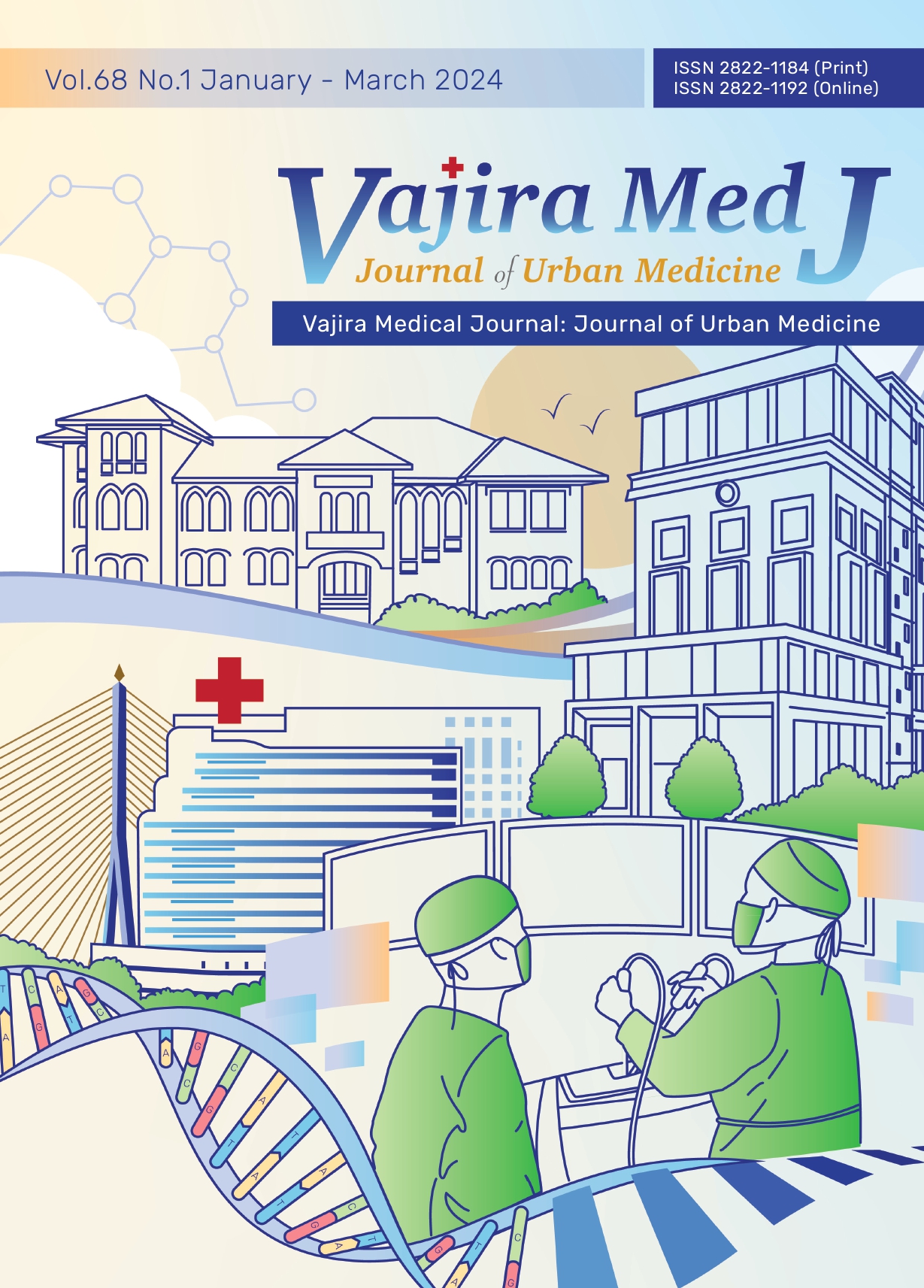Appropriate Use of Anticoagulants among Nonvalvular Atrial Fibrillation Patients at a University Hospital in Thailand Appropriate Use of Anticoagulants among Nonvalvular Atrial Fibrillation Patients
Main Article Content
Abstract
OBJECTIVE: Warfarin is primarily used for stroke prevention in atrial fibrillation (AF) patients in Thailand. Novel oral anticoagulants (NOACs) are used less commonly due to their high cost. This study aimed to evaluate the appropriate use of anticoagulants and clinical outcomes among nonvalvular AF (NVAF) patients.
METHODS: This retrospective study collected data from the electronic medical records of patients who were diagnosed with NVAF between January 2014 and December 2019 at the Faculty of Medicine, Vajira Hospital. Baseline characteristics, prescribed indication, types and doses of anticoagulant, and ischemic and hemorrhagic outcomes were recorded and analyzed.
RESULTS: We analyzed 783 patients with NVAF in this study. Of these, 539 (68.90%) were treated with oral anticoagulants (OAC), including 344 patients (43.90%) with warfarin therapy and 195 (24.90%) with NOACs. Meanwhile, 492 (73.10%) patients with CHA2DS2VASC score ≥ 2 received OAC therapy that was suitable for their indication. Of the 344 patients who received warfarin, 112 patients (32.60%) had an optimal time in therapeutic range (TTR) level of ≥ 65%. Of the 195 NOAC patients, only 98 (50.30%) received appropriate doses of NOACs. There was no statistically significant difference in the overall incidence rates of ischemic stroke/systemic embolism, bleeding, cardiovascular death, and all-cause death between the warfarin and NOACS groups. Appropriate TTR levels in the warfarin group was associated with significantly lower incidence rates of cardiovascular death (hazard ratio: 0.14; 95% CI: 0.02–0.79; p = 0.02) and all-cause death (hazard ratio: 0.36; 95% CI: 0.12–0.87; p = 0.01), than inappropriate TTR levels.
CONCLUSION: Most NVAF patients received oral anticoagulants with the appropriate indication. Warfarin is the most prescribed oral anticoagulant for patients with NVAF. About half of the patients received inappropriate doses of oral anticoagulants that potentially adversely affected the study outcomes of cardiovascular and all-cause deaths.
Downloads
Article Details

This work is licensed under a Creative Commons Attribution-NonCommercial-NoDerivatives 4.0 International License.
References
Kiatchoosakun S, Pachirat O, Chirawatkul A, Choprapawan C, Tatsanavivat P. Prevalence of cardiac arrhythmias in Thai community. J Med Assoc Thai 1999;82(7):727-33.
Phrommintikul A , Detnuntarat P , Prasertwitayakij N, Wongcharoen W. Prevalence of atrial fibrillation in Thai elderly. J Geriatr Cardiol 2016;13(3):270-3.
Kannel WB, Wolf PA, Benjamin EJ, Levy D. Prevalence, incidence, prognosis, and predisposing conditions for atrial fibrillation: population-based estimates. Am J Cardiol 1998;82(8A):2N-9N.
January CT, Wann LS, Alpert JS, Calkins H, Cigarroa JE, Cleveland JC, et al. 2014 AHA/ACC/HRS guideline for the management of patients with atrial fibrillation: a report of the American College of Cardiology/American Heart Association task force on practice guidelines and the Heart Rhythm Society. J Am Coll Cardiol 2014;64(21):e1-76.
Steffel J, Verhamme P, Potpara TS, Albaladejo P, Antz M, Desteghe L, et al. The 2018 European Heart Rhythm Association practical guide on the use of non-vitamin K antagonist oral anticoagulants in patients with atrial fibrillation. Eur Heart J 2018;39(16):1330-93.
Huisman MV, Rothman KJ, Paquette M, Teutsch C, Diener HC, Dubner SJ, et al. Antithrombotic treatment patterns in patients with newly diagnosed nonvalvular atrial fibrillation: the GLORIA-AF registry, phase II. Am J Med 2015;128(12):1306-13.e1.
Krittayaphong R, Winijkul A, Methavigul K, Wongtheptien W, Wongvipaporn C, Wisaratapong T, et al. Risk profiles and pattern of antithrombotic use in patients with non-valvular atrial fibrillation in Thailand: a multicenter study. BMC Cardiovasc Disord 2018;18(1):174.
Kirchhof P, Benussi S, Kotecha D, Ahlsson A, Atar D, Casadei B, et al. 2016 ESC guidelines for the management of atrial fibrillation developed in collaboration with EACTS. Eur Heart J 2016;37(38):2893-962.
Lip GYH, Banerjee A, Boriani G, Chiang CE, Fargo R, Freedman B, et al. Antithrombotic therapy for atrial fibrillation: CHEST guideline and expert panel report. Chest 2018;154(5):1121-201.
Urbonas G, Valius L, Šakalytė G, Petniūnas K, Petniūnienė I. The quality of anticoagulation therapy among warfarin-treated patients with atrial fibrillation in a primary health care setting. Medicina (Kaunas) 2019;55(1):15.
Rosendaal FR, Cannegieter SC, van der Meer FJ, Briët E. A method to determine the optimal intensity of oral anticoagulant therapy. Thromb Haemost 1993;69(3):236-9.
Molteni M, Polo Friz H, Primitz L, Marano G, Boracchi P, Cimminiello C. The definition of valvular and non-valvular atrial fibrillation: results of a physicians’ survey. Europace 2014;16(12):1720-5.
Mehran R, Rao SV, Bhatt DL, Gibson CM, Caixeta A, Eikelboom J, et al. Standardized bleeding definitions for cardiovascular clinical trials: a consensus report from the Bleeding Academic Research Consortium. Circulation 2011;123(23):2736-47.
Yu AY, Malo S, Wilton S, Parkash R, Svenson LW, Hill MD. Anticoagulation and population risk of stroke and death in incident atrial fibrillation: a population-based cohort study. CMAJ Open 2016;4(1):E1-6.
Krittayaphong R, Chantrarat T, Rojjarekampai R, Jittham P, Sairat P, Lip GYH. Poor time in therapeutic range control is associated with adverse clinical outcomes in patients with non-valvular atrial fibrillation: a report from the Nationwide COOL-AF Registry. J Clin Med 2020;9(6):1698.


